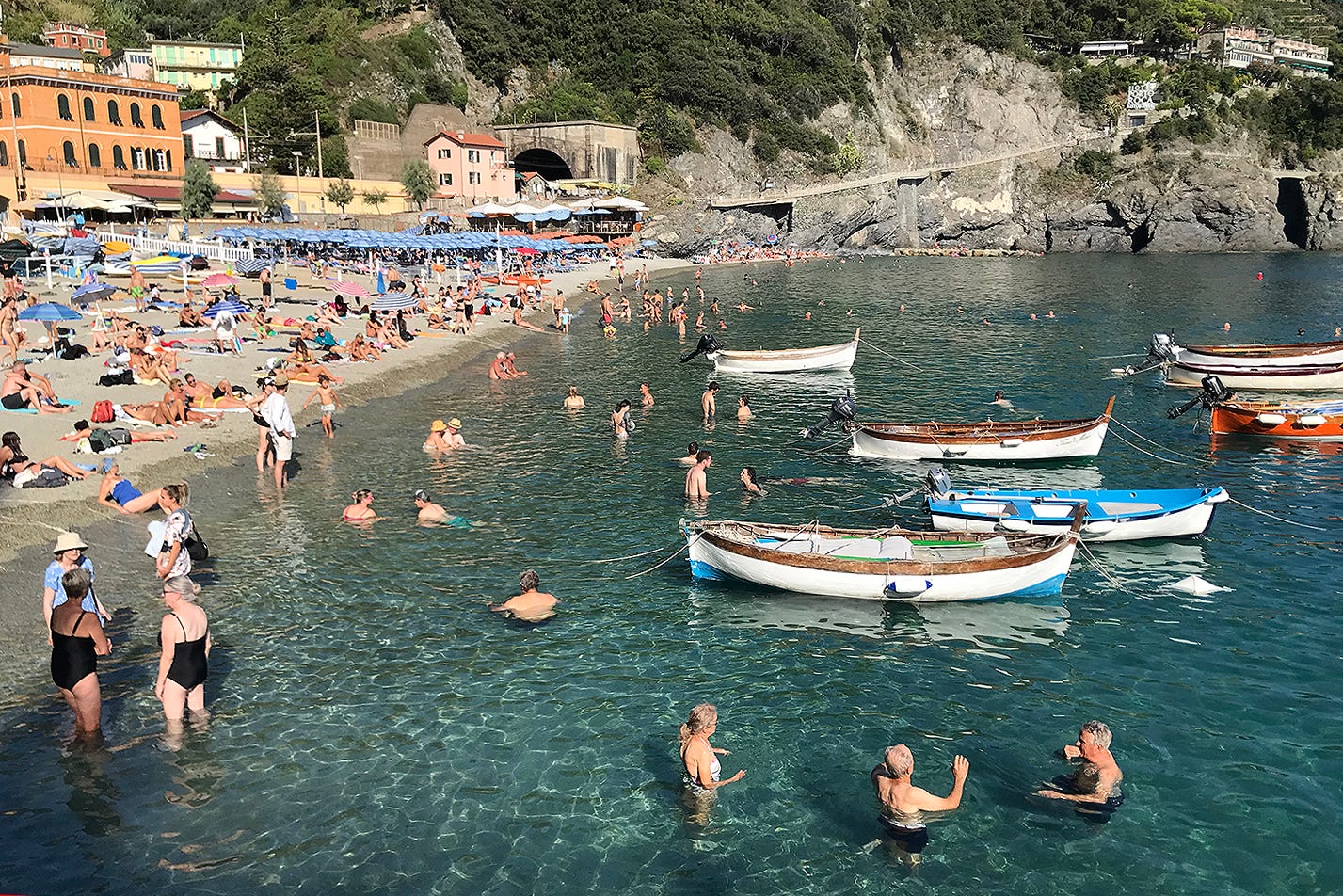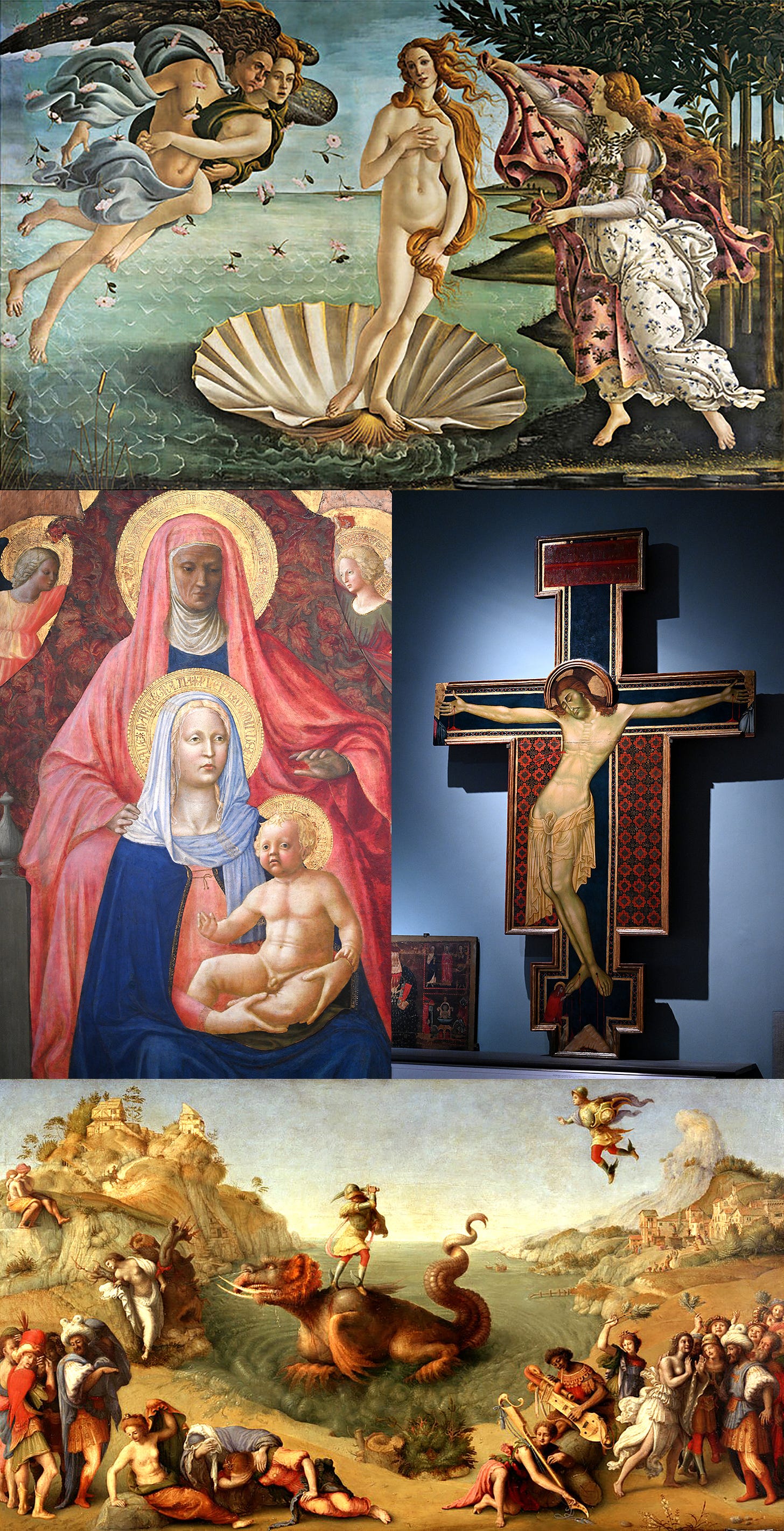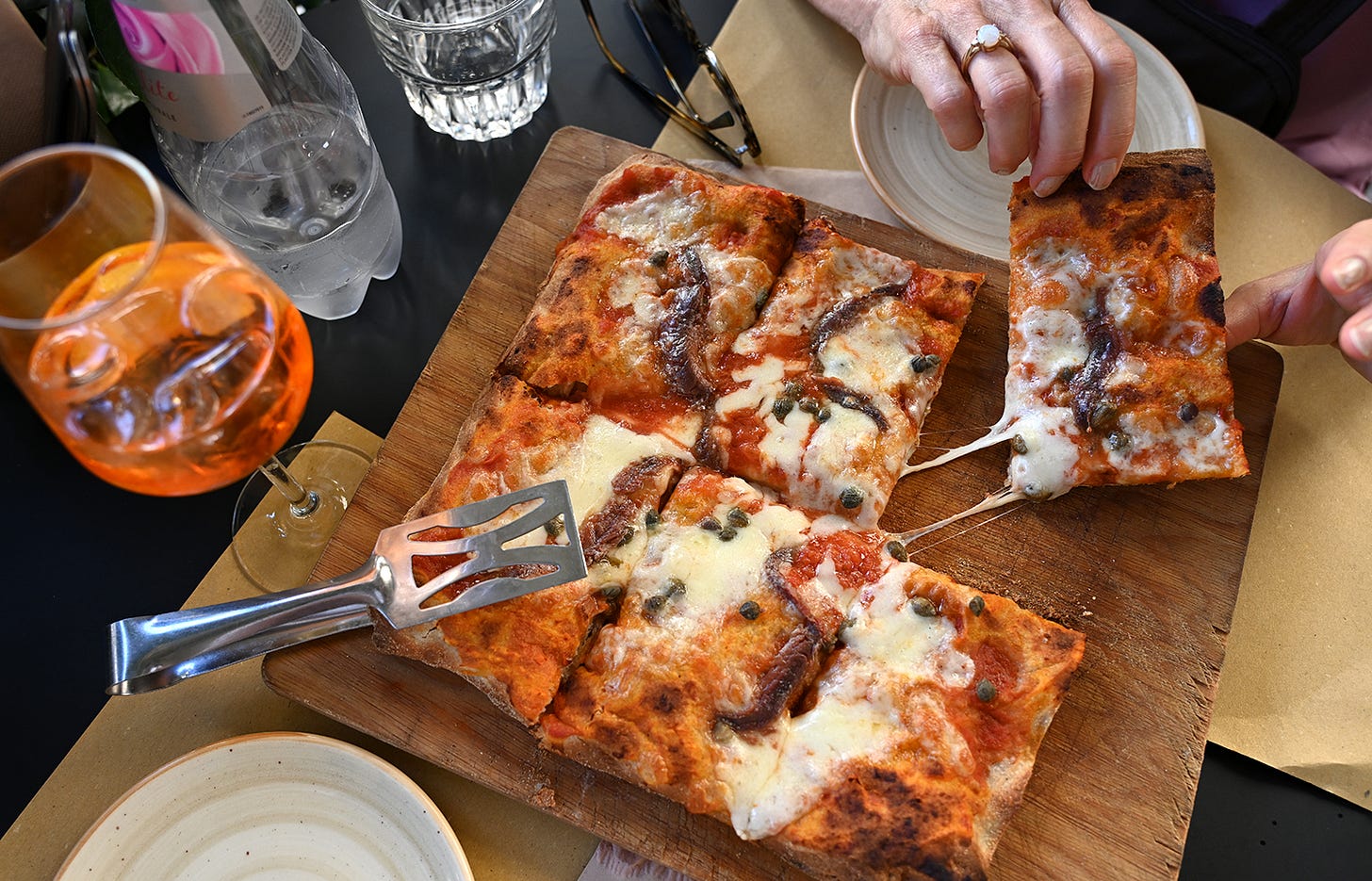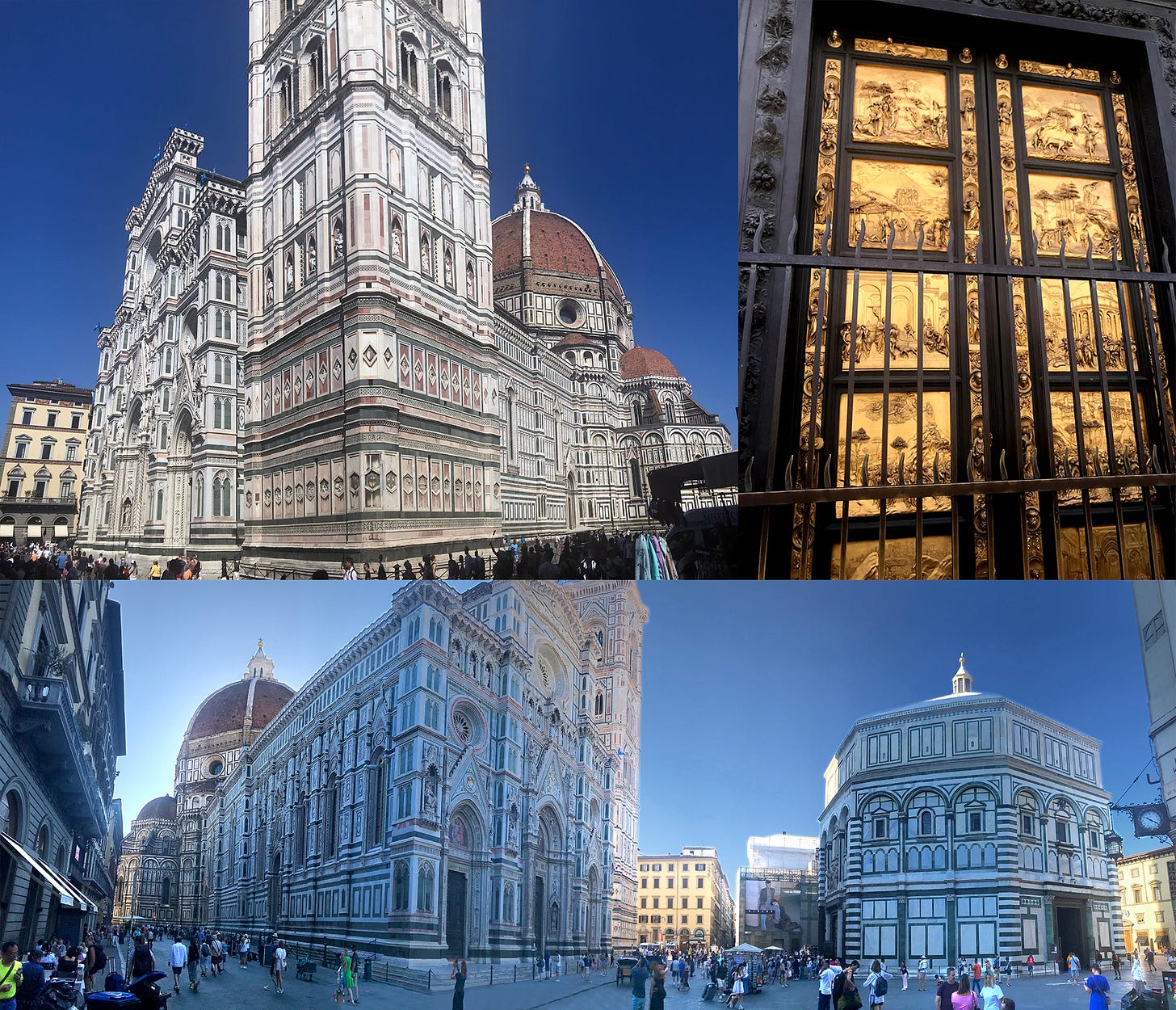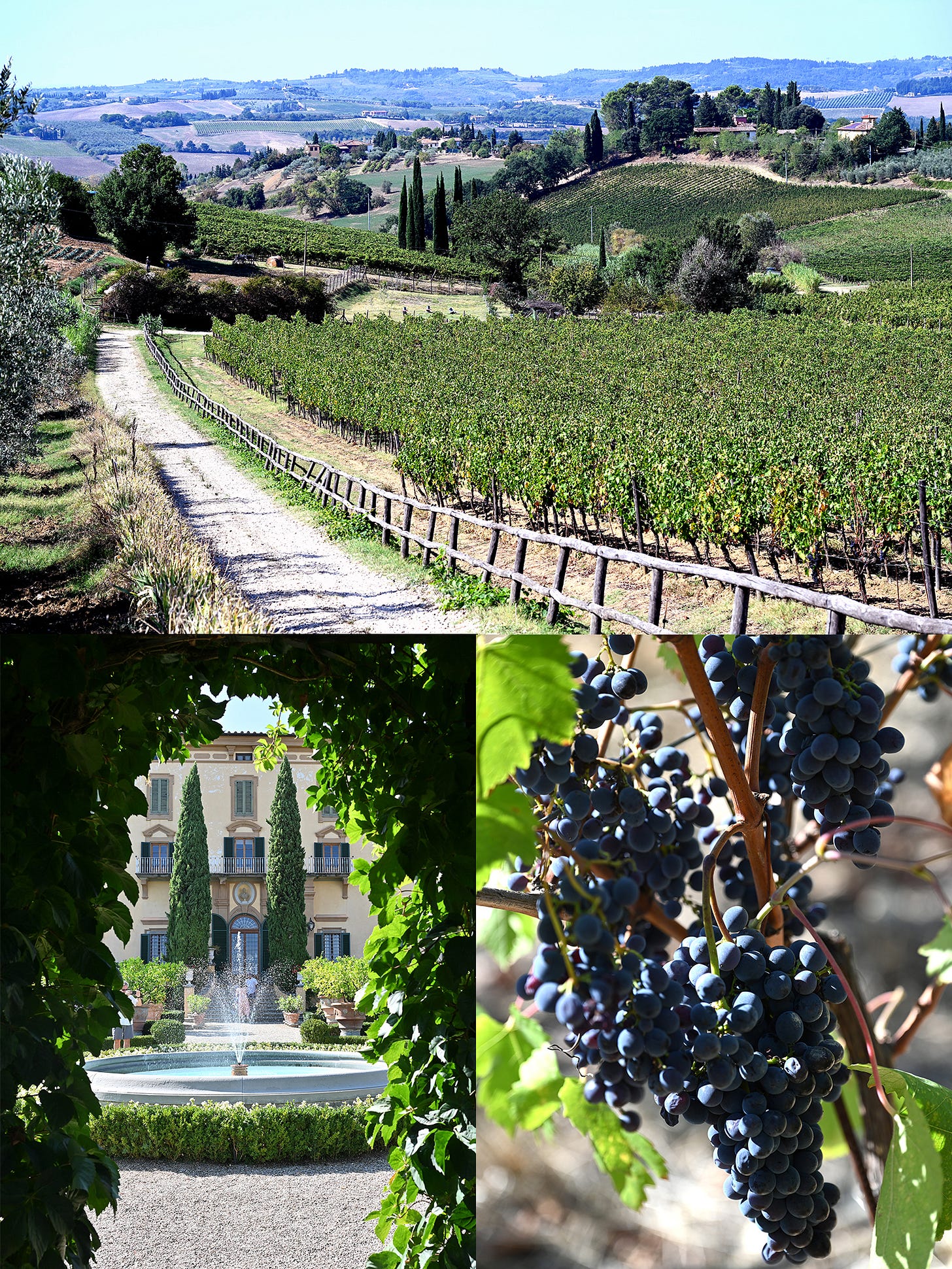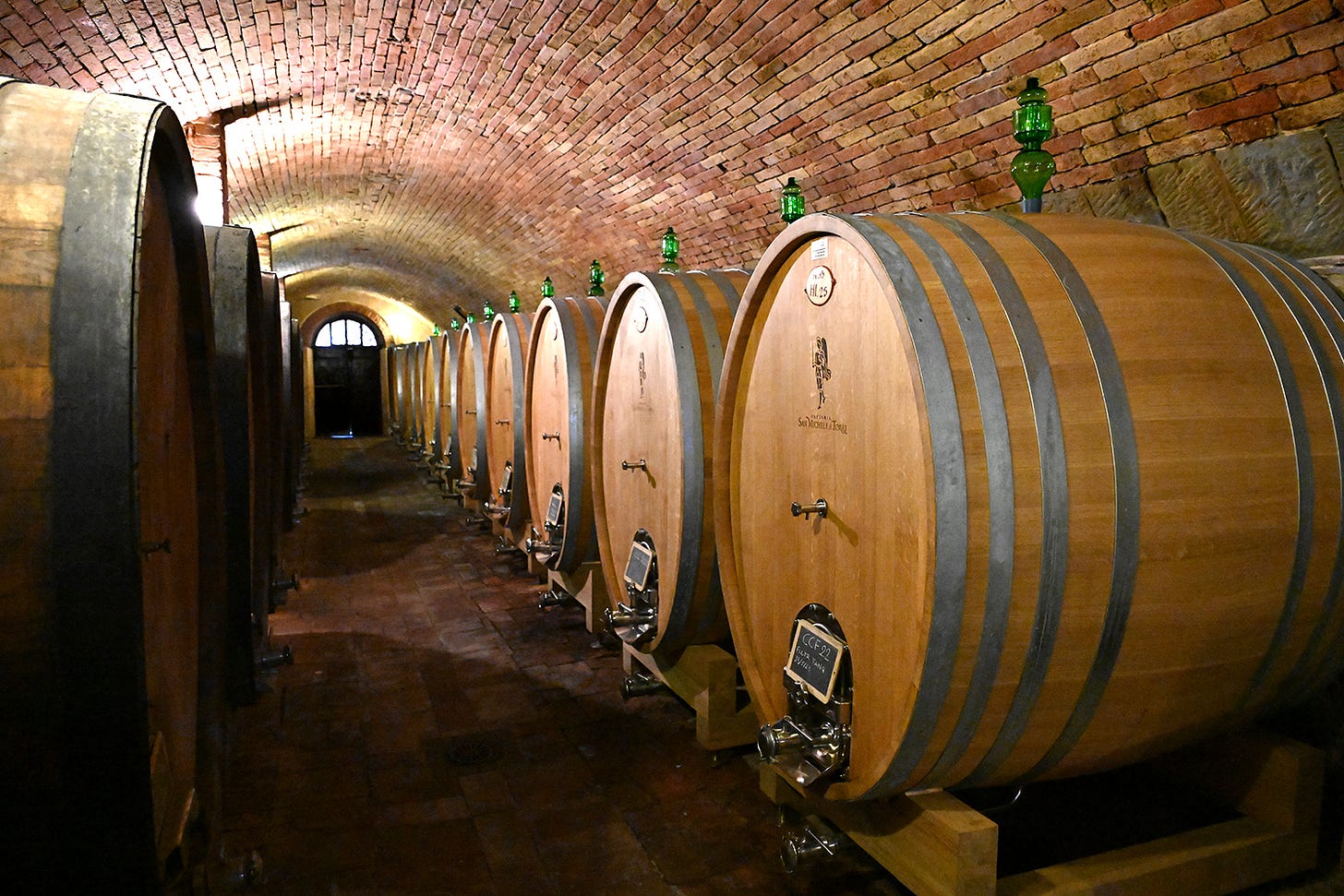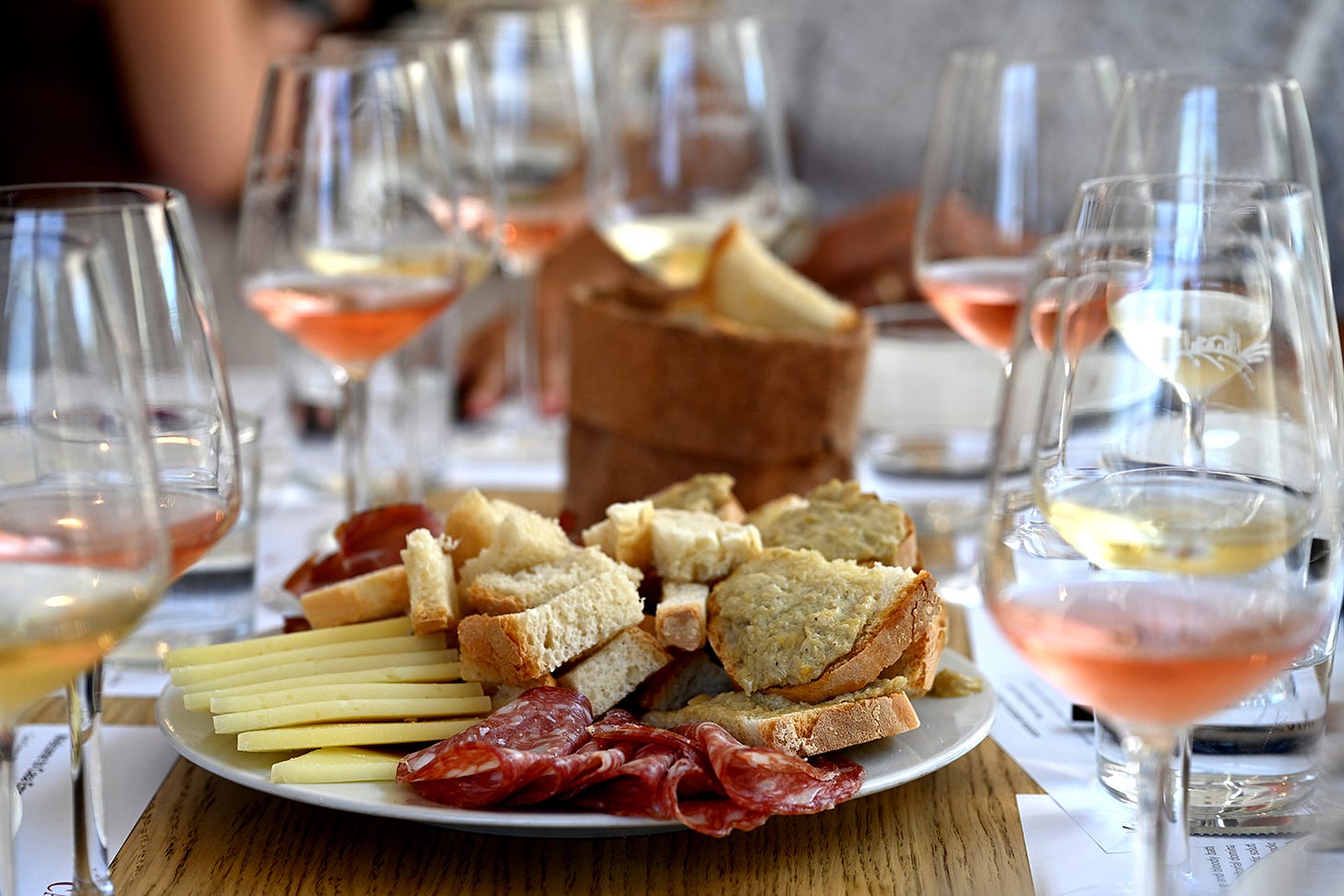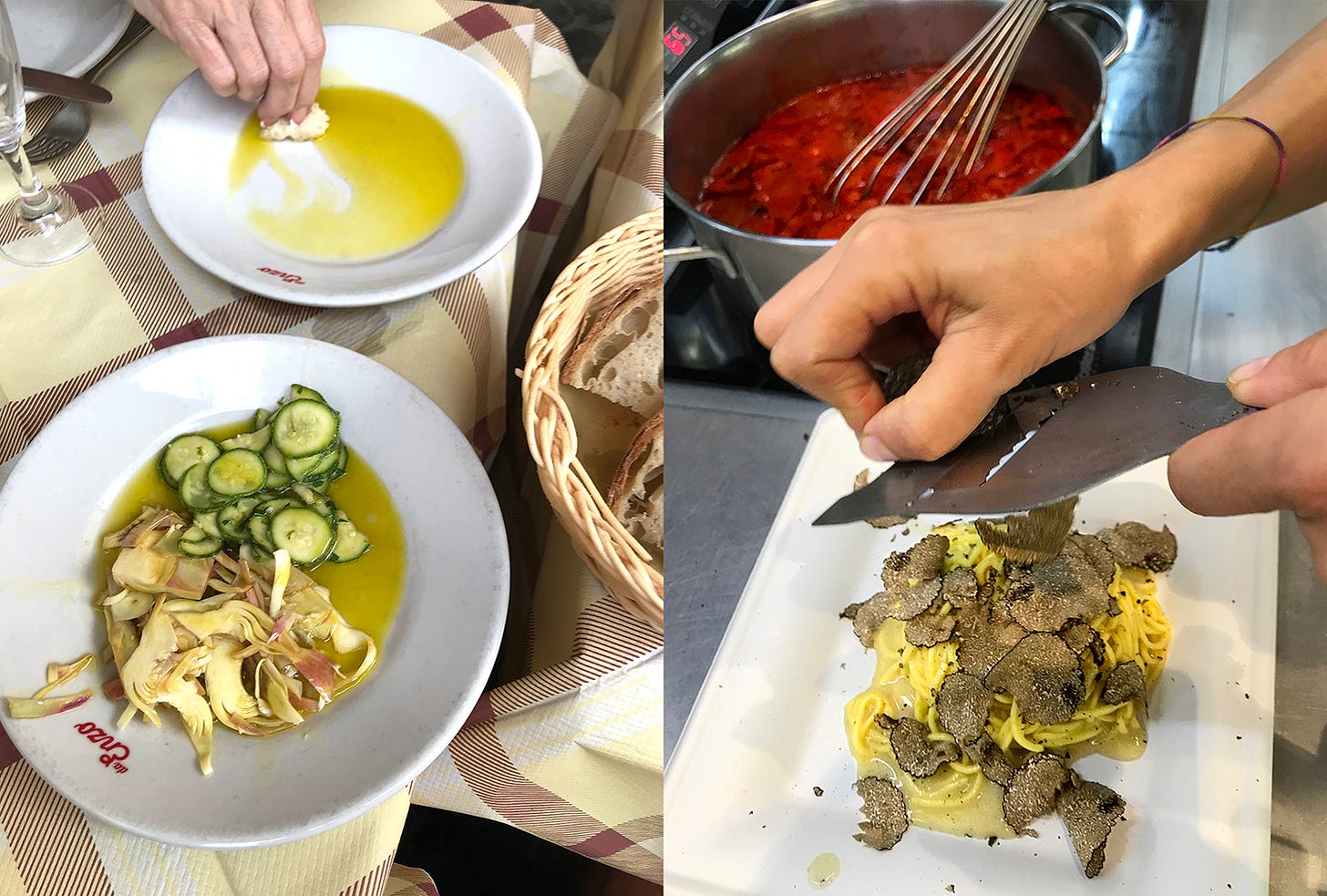A Harvest Tale - Part 3
More Italian travels and travails, and how to make Rose from 6,000 miles away.
The trouble with eating Italian food is that five or six days later you're hungry again. — George Miller
Florence
Okay, so where were we? Oh yeah… returning from the fifth and southernmost village of Cinque Terre, Riomaggiore, via ferry ride back north to the first, Monterosso, after a long day of hiking and eating in between. Hard to believe, but we actually passed up dinner that night, surrendering instead to the physical and food fatigue of the day.
Saturday, September 9 - Another fantastic Euro breakfast spread at the Souvenir hotel—we seemed to have gotten our appetites back!— and then it was off to the cultural and art capital of the world via a madcap train schedule from Monterosso to Pisa, and Pisa to Florence.
Just a quick aside. In hindsight I wish we had packed bathing suits and had booked one more day in Monterosso. The beach scene there is awesome, and the European tourists take their sunbathing and sea swimming seriously. A day of that would have been energizing for the excess of stimuli to come.
So onward. We arrived in Florence in the early afternoon, grabbed a cab from the train station (apparently along with everyone else on every train) and found our amazing, super-modern Airbnb apartment just outside of the tourist zone but within easy walking distance to everything. Great score, Deb!
One of the essential things to know about sightseeing in Italy, which Deb discovered early and used with great results, is if you can buy your tickets to museums, tours, or special exhibits in advance, do it. In almost every situation, having that in hand will allow you to skip the inevitable and insanely long lines of people waiting to get in. And so was the case when we showed up at the Galleria dell'Accademia that afternoon at our assigned time to see Michelangelo’s David.
I’ve seen the David in situ before; you may have as well. And almost everyone has seen it in books and online countless times. But when you walk into that wide hallway of the Accademia and look towards the skylight-illuminated domed room to where this hallowed 17-foot-high statue is standing on a marble pedestal above the heads of all who have come to revere, you lose your breath.
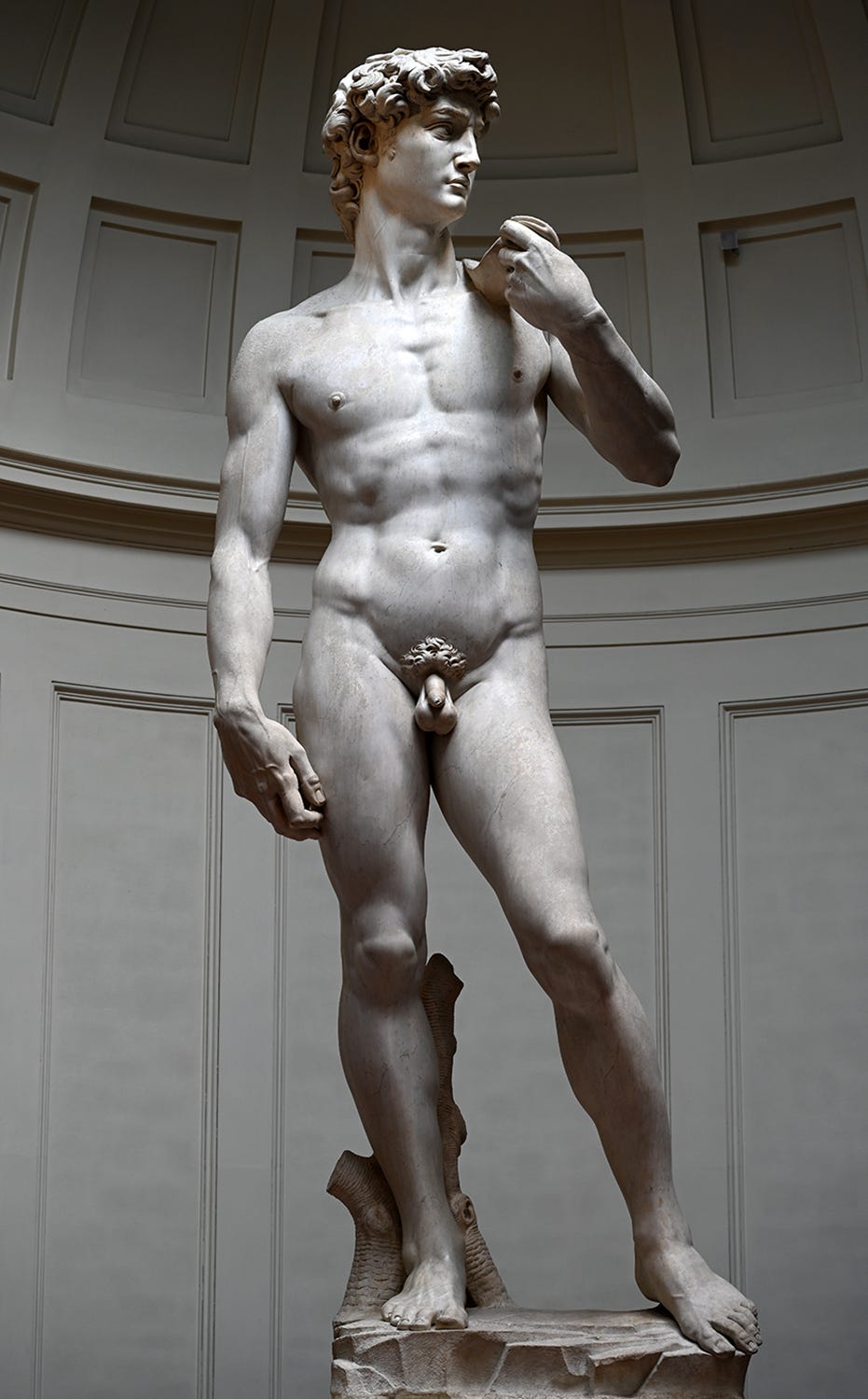
Afterwards, we found a little bar in the Piazza di San Marco a few blocks from our lodging, and while sharing a couple of focaccia sandwiches and a bottle of Il Nostro Chinotto—a deliciously bitter carbonated Italian soda that tastes very similar to Coca Cola—we giggled like kids recounting our awe and amazement at what we had just experienced. It all just somehow made the world seem better for a little while that such beauty and art still existed.
Sunday, September 10 - If there was a single day in Italy that solidified my appreciation of art and challenged my faith in humanity at the same time, it was today. We ate a quick breakfast at the corner bar in Piazza di San Marco (which had quickly become our hub), and then took a brisk walk to and through the Piazza del Duomo and the not-to-be-believed Cathedrale di Santa Maria del Fiore, to the Uffizi Gallery. We’d be back for a tour of the Duomo tomorrow, but right now we were about to be immersed in one of the most incredible museums in the world, with artwork from the Middle Ages to the Modern period. Its collections of paintings and drawings from the 14th-century and Renaissance period include some absolute masterpieces, among them Botticelli, Leonardo, Michelangelo and Caravaggio.
Expletive, expletive, expletive. I won’t take the time or the space here to talk about everything we saw, but it was endless and spectacular, and absolutely not to be missed. Three hours later we emerged—I, for one, mentally spent and somewhat in shock, especially at my own naiveté. How could it be that there was so much incredible art created back then, and so much of it is still in existence today as testament to a time when culture and science reemerged from the dark ages and the future of humanity held such promise? And all this just from the land of the ancient Romans. What of the rest of the world? I struggled with this realization and wondered what had happened to that promise in the contradiction of today’s troubled world. Art and excellence always do that to me. I can’t believe they coexist with war and social inequity.
I mean… Whoa. Not the time or the place.
Enough of my unresolved emotional response, let’s get physical. Both of us were starving, yet again, and we grabbed a table at the first trattoria we could find. We devoured plates of thick, hand-rolled pici pasta with tomato and garlic, and a salad of sun-dried tomato and fresh mozzarella—all washed down with one of the most popular white wines in Italy, Ruffino Orvieto Classico, a delicious fruity blend from Umbria with a distinct mineralogy and a floral bouquet of green apples and flowers. It’s made of Procanico (a small-grape variety of the Trebbiano), Grechetto (a white Italian grape variety of Greek origins), Canaiolo Blanco (a name given to at least six different white grape varieties grown in Tuscany) and Verdello (a minor blending grape grown mostly in Umbria)—so just try and replicate that in California!
Back to our Airbnb for our afternoon siesta… scusa, volevo dire riposo. I awoke hours later to darkness, too crashed for dinner. Deb went out and grabbed an egg sandwich and small spinach quiche which we shared before once again succumbing to it all. Sheesh, a couple of late-night rabble rousers are we!

Monday, September 11 - The day we finally eat three full meals, and then some. Is it true you can stretch your stomach? We grabbed a cappuccino and a tea to go in Piazza di San Marco (coffee creatures of habit) and then headed back to Piazza del Duomo, where we sat down for a real breakfast at the outdoor tables of a trattoria adjacent the beautiful octagonal Baptistery of St. John. Scrambled eggs and the Italian version of bacon, which was an insanely good, very salty, crispy-fried pork belly sliced extremely thin. I also had a pistachio croissant filled with green slime worthy of Nickelodeon—very strange, almost too slimy to eat, but really delicious.
We then toured the Opera di Santa Maria del Fiore, which includes the Cathedral, Brunelleschi's Dome, Giotto's Bell Tower, the Baptistery of San Giovanni, Santa Reparata and the Opera del Duomo Museum, which was founded in 1891 and radically renovated in 2015. It is renown not only for the artwork it houses, but for the avant-garde architectural and technological nature of its interiors and its state-of-the-art museographic equipment. Deb’s genius at securing advance tickets paid off handsomely as we competed for admission with literally thousands of other tourists with the same itinerary in mind.
Gaining access, we gasped in disbelief at the sculpture collection and cutting edge display design in the Duomo Museum, lit candles of offering in the immense Cathedral, were humbled by the genius of Brunelleschi's Dome (but skipped the 463 claustrophobia-inducing steps to the lantern), we also skipped the 414 steps to the top of Giotto's 278-foot tall Bell Tower (are we getting old, or simply too sated?), and took a very deep dive into the archaeological treasures of the ancient basilica of Santa Reparata—the church within a church built in the 5th century on a site now beneath the Cathedral, and had an MC Escher moment with the mosaic floors in the Baptistery. It was a mind-bending and heart-stopping morning, delivering yet another onslaught to our already over-stimulated souls.
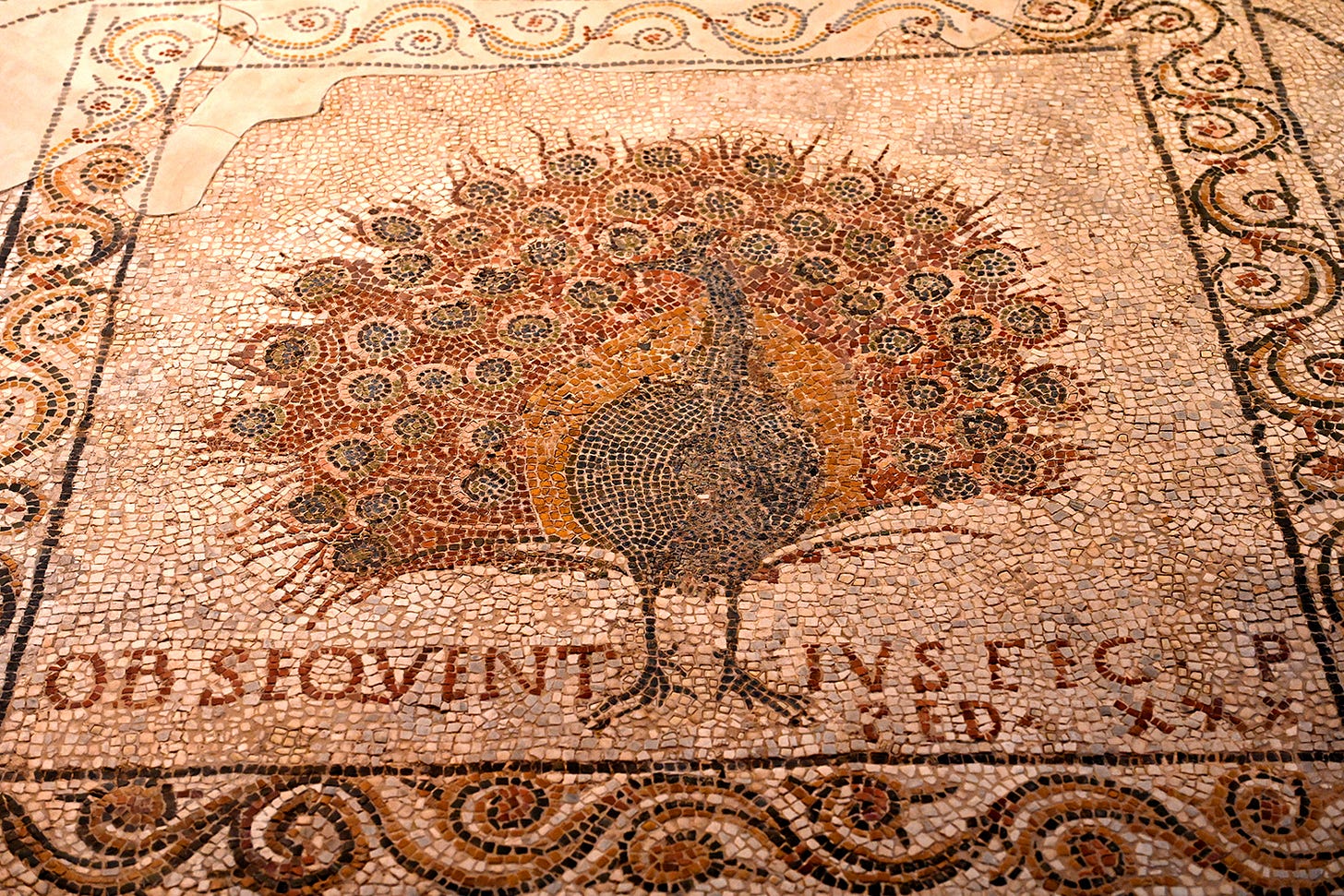
For the past few days, our lunch venues have become places of refuge and recovery—aesthetic time-outs, if you will. And today was certainly no exception; in fact it might have been the best example yet as I ordered a mid-day Apernol spritz even before we were seated in a beautiful palm-filled outdoor pizzeria we had scoped out the day before. We went totally native in the way of American tourists, ordering a deep-dish pizza with tomatoes, capers and very salty sardines. It was la migliore pizza di sempre!
Walking back home after lunch we finally caved and had our first gelato, which is amazing that it had taken us this long as there seems to be a gelateria on every corner. Conventional wisdom has it that the places with high towers of gelato are not as good because the gelato must not be selling very fast and is “old.” But my sweet cherry and sour lemon, scooped from foot-high, technicolor towers of pure frozen flavor, literally redefined ice cream for me.
Another day, another riposo.
Then a long, slow, late (hey, just like the Italians!) dinner at Ristorante Accademia in Piazza di San Marco near our Airbnb. I chose a super Tuscan wine from Bolgheri, suggested by the owner of the Ristorante. It was a totally happening blend of Cabernet Sauvignon, Merlot, Syrah, Petit Verdot and Sangiovese, although I have no idea of the percentages. This to go with a perfectly cooked, medium-rare, utterly delicious Florentine Steak (T-bone) with sea salt, an incredible wild mushroom strudel, and a beautiful eggplant timbale. Not sure how, but it just keeps getting better!
Tuesday, September 12 - Our last full day in Florence, and oh, so fitting that we would spend it on a wine tasting tour in nearby Tuscany. Grabbing the requisite coffee, tea and croissant along the way, we walked to where we were supposed to meet our guide and comfortable Mercedes coach. I was totally stoked for this day! For a rookie American winemaker, legendary Tuscany was like going to Italian Mecca—land of Sangiovese and its distinctive red wines, Chianti Classico, Vino Nobile di Montepulciano, the famed Super Tuscans, and the venerable Brunello di Montalcino.
And don’t forget the utterly delicious, fresh, crisp and refreshing—okay, perfect—white wines of Tuscany made from such stalwart local grapes as Verdicchio (also known as Trebbiano di Soave), Vernaccia, and Vermentino.
We would taste many of them.

As our coach labored up the steep approach into the wine country of Tuscany, I was struck by two observations. First, by just how close we still were to Florence. There were several pullouts along the road where you could actually look to the south and see the Duomo rising up above the city only a few miles away.
Second, just how much Tuscany looked like the wine country of Napa or Sonoma. Oh please, such Yankee arrogance! I meant to say, just how much the wine country of Napa and Sonoma looked like Tuscany. Remind me, which came first, the chicken or the egg? You can clearly see all of the accoutrements of Tuscany that have been borrowed (stolen) by the architects and designers of wine villas in northern California.
Our first stop was San Michele a Torri, an organic farm with 40 hectares of olive groves, 55 hectares of vineyard and a winery born from the ruins of an ancient medieval villa. It is located in the heart of Chianti just 15 km from Florence. This was the only winery to invite us into their barrel room, which was impressive with huge oaken casks adorned with beautiful, handblown green glass airlocks.
Our second stop was Casa Emma, founded in 1969 through the vision of a “brilliant and far-sighted” woman, Fiorella Lepri. The winery proclaims a laudable vision and mission statement focusing on environmental sustainability. They actually seem to walk the talk by becoming a plastic-free company that has reduced the weight of their wine bottles by 25%; by following biodynamic and organic viticulture principles, including the use of domestic geese for fertilizing, grass and weed control, and to help avoid soil compaction; by reducing bio-waste by focusing on a recycling logic which includes the development of Casa Emma Grape Pomace Flour, produced by drying and grinding grape skins after the vinification process; by producing and using only renewable energy derived from solar panels throughout the entire winemaking process; and by making sure that almost all the operations in the vineyards are carried out manually, including picking.
Our final stop was Poggio Torselli, a private villa with its wealthy owner-family in residence. This villa has an ancient history—1427 Poggio Torselli was born—and a modern rebirth—2003 a new winery is built in time for the first vintage. But it wasn’t until 2018 that the current owner proclaims the beginning of a new course of Poggio Torselli. This course includes the only mention of “minimal intervention” winemaking I encountered on this trip, with the winery claiming “the fermentation of grapes is spontaneous with the use of indigenous yeasts only and no additives of any kind are used in the cellar apart from small quantities of sulfur dioxide at the time of bottling. The stay on the lees is one of the fundamental steps to increase softness and complexity, but it also plays an essential role in protecting the wine, allowing to drastically reduce the use of sulphites.”
The day was wonderful, our guide was knowledgeable, our tour companions were pleasant, and the wines were very good. But I have to admit that I was never actually blown away by any single cuvée. This may have been because the majority of the wines we sampled were Chianti Classico, a wine I find delicious and essential on the table, but rarely mind-bending. The tastings were not unlike many of those you might experience in California wine country, with perhaps a little more emphasis on food pairing as we were never without something to eat.
In between all this, we made a pit stop in Greve—a small village known as the gateway to Tuscany—where we bought gelato and toured the gift boutiques and a Chianti-themed wine shop busting at the seams with bottles adorned with black roosters—the symbol of Chianti.
Wednesday, September 13 - Another “Day of Food,” how can that possibly be? But we were headed to Rome, our final destination, and Deb had us scheduled for a swan song four-hour food tour upon our arrival. But first, yeah, you got it, an coffee, tea and croissant as we rolled our tiny carryons and hoisted our backpacks along the way to the train station.
We were doing just fine until we came across… the Central Market. It was just by chance, no premeditation here, although I think Deb may have mentioned it. But big markets in foreign cities demand exploration and we bumped our suitcases up the entry steps into a sea of Italians haggling for the best meats and seafood and vegetables and breads. Then that damned Rick Steves guidebook—or was it the Earth Trekkers website?—suggested we check out the second floor which proved to be a food court not unlike those found in American malls, only with offerings you would actually want to eat. Hell, you were craving to eat!
It turned out to be a modern display of everything edible we had coveted so far on our trip to Italy, all together in one long room with friendly attendants. Deb was dumb-struck and thrown off her sense of meal scheduling and finally ordered a simple salad of sliced cucumber and artichoke hearts drowned in olive oil. I got sucked in by the truffle carney hawking a simple plate of pasta adorned with a landslide of sliced dark truffles.
It was a miracle that we made our train to Rome.
I could go on now and finish this short-story-gone-long about our trip to Italy, only something else was happening that very day over 6,000 miles to the west. My first harvest of the season was about to get underway in Sonoma, only I wasn’t there.
Making Rosé 6,000 miles away
This is how it all came down. Two guys were playing golf at a private club in Sonoma sometime around the middle of August. They’d never met before, but somehow they got to talking about their homes in the area and how each of them had a vineyard. One of them allowed as to how he’d met a winemaker (that be me) who was doing a good job coaxing early vintages out of his still very young vineyard, and there were high hopes that this year was going to be the first chance at a real harvest. The other guy commented on the fact that he had just bought land in town and was planning on moving from his longtime abode up in the hills above Sonoma after building a house on the new property, which, by the way, had a very mature vineyard of old vine Zinfandel. He then let on that he could use a winemaker like the first guy had. So, the first guy gave the second guy my contact info, and voilà, the Tiny Vineyard Wine Company has a new client and a new source of grapes.
It turns out that the guy who bought the new property in Sonoma, and who hired me after the good reference from the other guy, planned to build his new house smack dab in the middle of the existing old vine Zinfandel vineyard. I thought that was pretty cool—the guy wanted to live amongst the vines. Of course, to do so required clearing a goodly portion of the vineyard to make room for the house, and that was going to happen soon, as in a month or so. Based on that schedule it was unlikely I’d be able to harvest those vines before they were torn out, particularly given the unusually long ripening season we were having.
Then I had one of those good ideas you only have in the shower or while jogging for a few miles.
If the vines were likely to be removed before the heavy clusters of grapes they were already carrying became ripe enough to harvest, what if we picked early and made a Rosé? That would only require that the grapes reach a sugar level of about 19° or 20° Brix instead of the 25° to 26° Brix required for a big, bold Zinfandel. It would also probably mean that this would happen while I was in Italy, and I’d have to manage it all from there. And then, what the hell would we do with all those grapes once they were picked? Who would shepherd them through pressing and fermentation, and get them safely into a tank with enough sulfur to inhibit MLF if I wasn’t home by then?
I ran the problem past Jack at Magnolia and he responded more favorably than I would had hoped. It might have been because the season had been late in developing and they were surely going to still be twiddling their thumbs at Magnolia come mid-September, and they’d be looking for something to do. But to Jack’s credit, he’s almost always been a “can do” guy, plus he has a personal affinity for Zin Rosé.
“Can I leave it in your hands if the schedule all goes bust?” I inquired. “Sure, we can handle that. Just email me the protocol you want us to follow and we’ll take care of it,” he replied. Of course, that would be a little like the student teaching the teacher, but I was game if he was.
So I arranged for my winemaking buddy J.W. to take weekly Brix readings and email them to me in Italy, I confirmed a drop dead date with the contractor who would be clearing the lot, I got on the radar of the vineyard manager who would provide a crew to do the picking and then deliver the grapes to Magnolia, and I went out and bought a used 500-liter variable level tank just to be sure something was available when the time came. And, I consulted with his eminence Clark Smith on yeast options—there were two depending on acid levels, I bought both—and a DAP-free nutrient he suggested for if the YAN was low.
Then I left for Italy, not due back for over two weeks.
Well, up until just a few days ago it had all been relatively quiet as J.W. continued to check Brix levels and keep me informed, then all at once it wasn’t. We were suddenly at 19° Brix, the weather was warming up, and the vineyard manager had a spot open in his schedule for Thursday, September 14. Tomorrow!
I fired off emails to everyone and pulled the trigger.
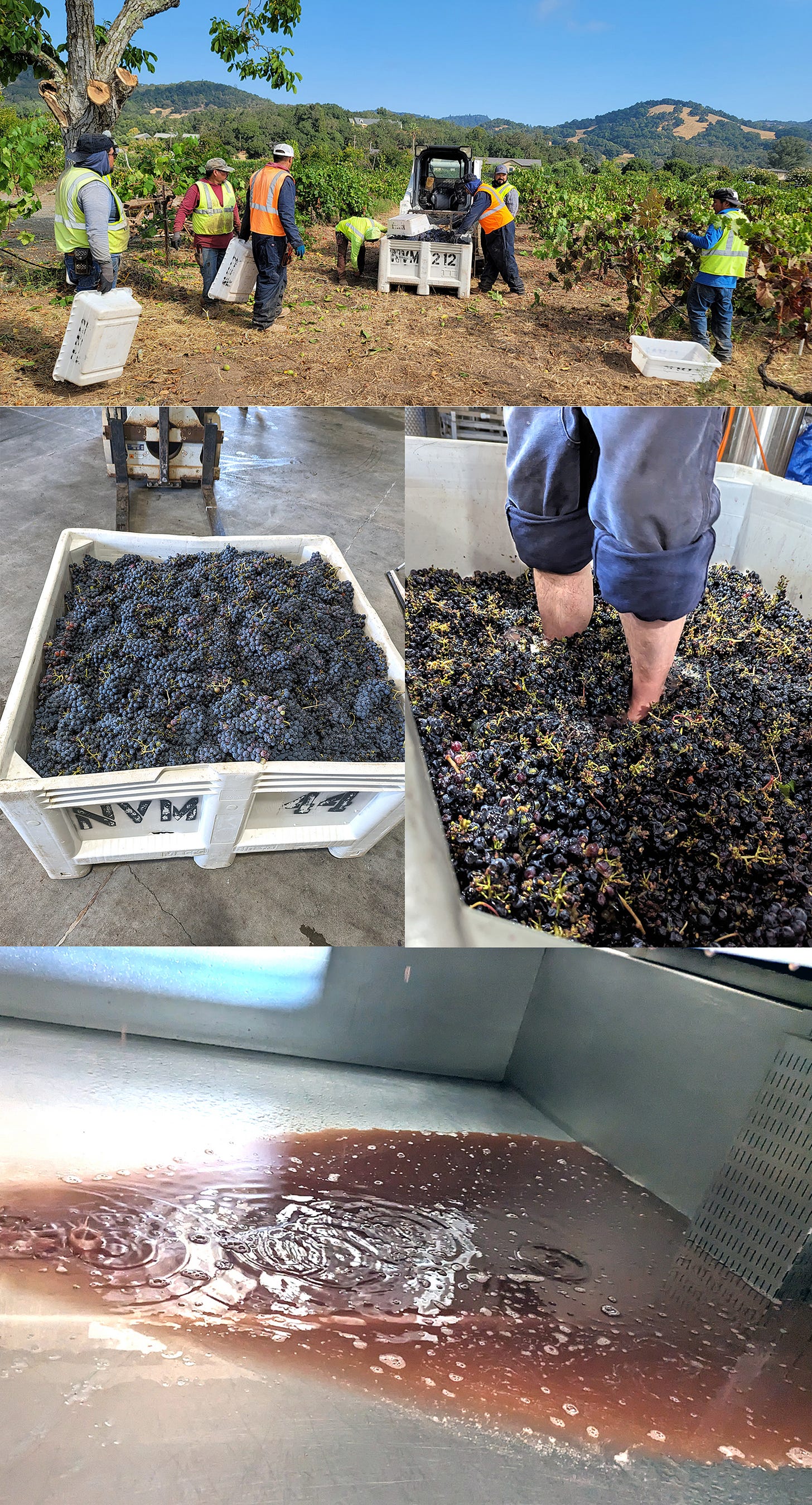
And you know what? Everything we had planned for pretty much happened without a hitch, and by midnight my time the next day 130 gallons of pale salmon-colored Zinfandel juice was in a settling tank while my team at Magnolia awaited results of a lab panel they had sent off that morning which would tell which yeast to use for fermentation and if they needed to add nutrients to the mix depending on YAN levels.
The next day they did what the chemistry told them to do and a day after that my 6,000-mile Rosé began to ferment, about the same time our flight from Rome, via London, touched down in San Francisco.
[The crowds get bigger and Deb and I pay the price, as our Italy trip wraps up in my next post.]



